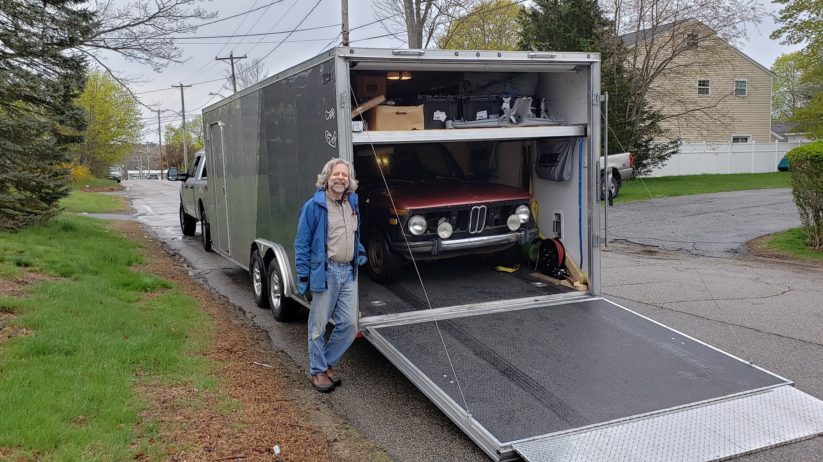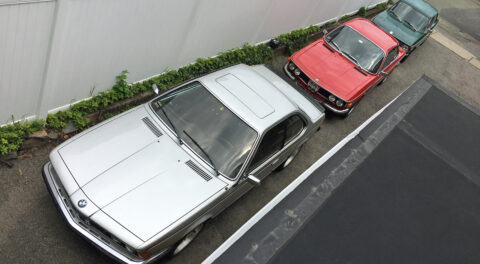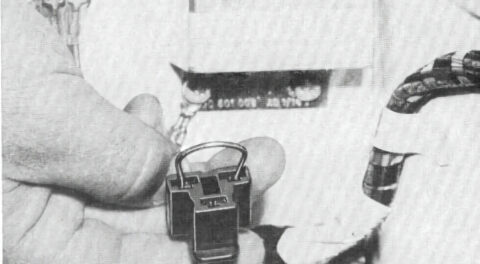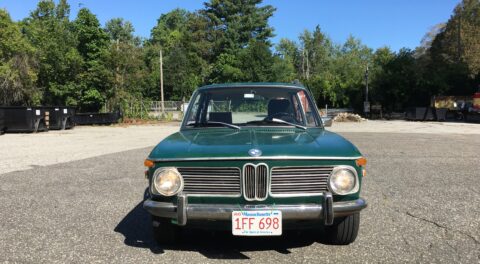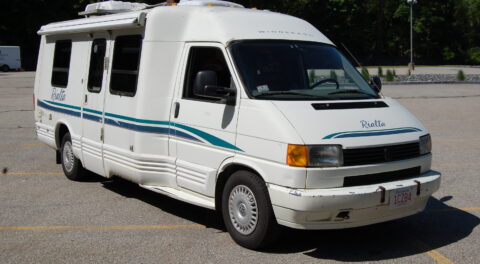Last week, I was offered (and accepted) a free faux (fake) 1973 2002tii. I’d looked at the car last year and, at the time, passed on it. I couldn’t remember the exact reasons why, but I assume I’d determined that the body was too far gone. A fake tii doesn’t have the value of a real one with the correct VIN, and I have neither the space nor the inclination to part out a car. Surprisingly, I couldn’t find any photos from when I’d checked out the car last year, but I did find a screen grab of the original Craigslist ad, and in it, the seller said he was firm on a $2000 asking price. I’m not above making offers even when someone says they’re firm, especially if the asking price is unrealistic, but I thought that what probably happened a year ago was that the condition of the car was simply too poor to spark my interest. Bending etiquette is only worthwhile if you want the item.
However, when someone offers you something like this for free, as happened here because the seller had held onto my contact info and now simply wanted the car gone, well, you put together the logistics, make space for it in your driveway, and figure out what to do with it later. My friend Tom Samuelson volunteered his sinew, truck, and trailer. We arranged to meet at the seller’s house in Brockton (south of Boston) last Sunday afternoon to pick up the car. I pulled a hundred dollars out of an ATM and stuffed the cash in my pocket. After all, pay-it-forward is great, but when people are offering you free cars and transportation, a gracious counter-offering of “take the significant other out for drinks” money is appropriate.
First, huge kudos to Tom. He’d been down in Connecticut for the weekend. To meet me, he needed to drive back north to his house in Marblehead, pick up his truck and trailer, head back south to Brockton, load up the car, drop it off at my house in Newton, then return to Marblehead. This was easily six hours of his time, so even in the context of pay-it-forward, it was a big favor for which I’m extremely grateful. Thanks, Tom.
I recalled that the car had been in the seller’s backyard, around the other side of the house from the driveway. Even though Tom’s trailer has an integrated winch, I threw my Warn PullzAll portable electric winch and a long extension cord in the trunk of the E39, figuring that it might be easier to drive my car into the backyard and use it as a stationary object from which to winch the dead car out of the grass. However, when we arrived at the house, I was relieved to find that the car had been moved to a canopy structure that was pretty much a straight shot from the driveway. What I didn’t remember was that the house was on a small hill, and to get the car down onto the street, it’d need to go down a pretty steep incline in the front yard.
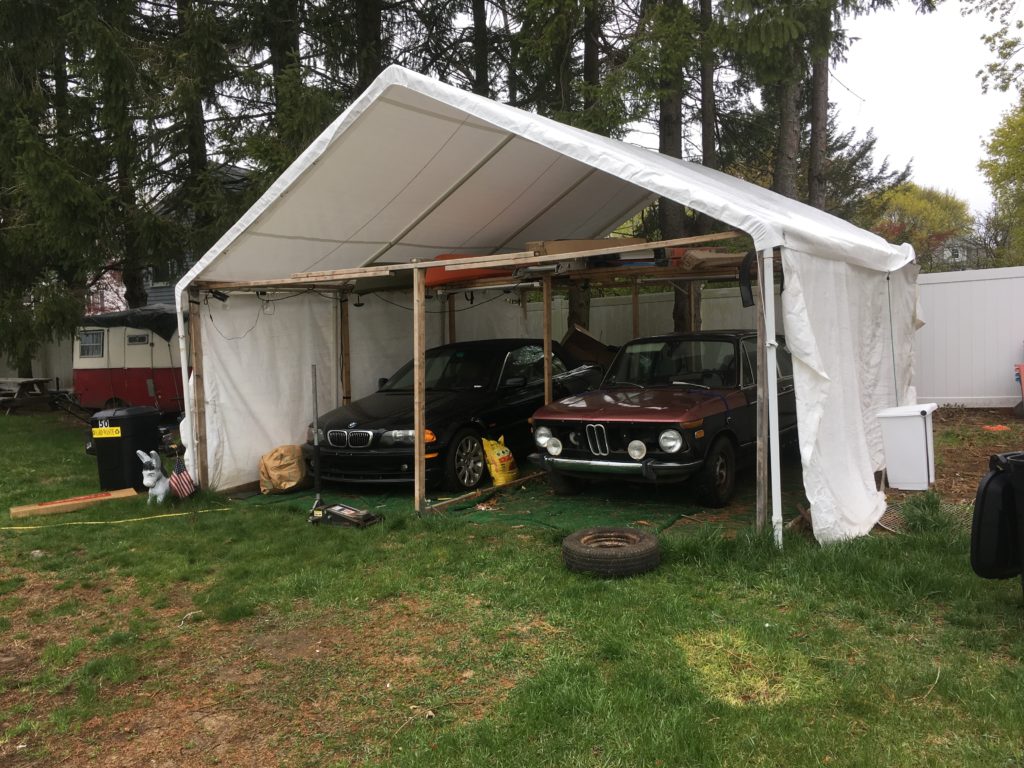
Not a bad makeshift structure to keep two cars out of the elements.
In the photo above, it looks like the car has a ’74 nose with black plastic grilles. It doesn’t. I remembered from the CL ad that the car had very nice-looking metal grilles as a ’73 should. As I approached it, I could see that the grilles simply had been removed. The seller said he’d put them in the trunk, as he knew they could easily be damaged.
In the e-mails leading up to Tom’s and my arrival, I’d asked how easy the car would be to move. The seller had mentioned that one of the tires wasn’t holding air, so I’d brought a wheel and tire with me. The first task was to get it on. I’d brought a small floor jack with me, but the seller had a bigger one positioned right there, for which I was grateful since the car wasn’t sitting on a hard surface.
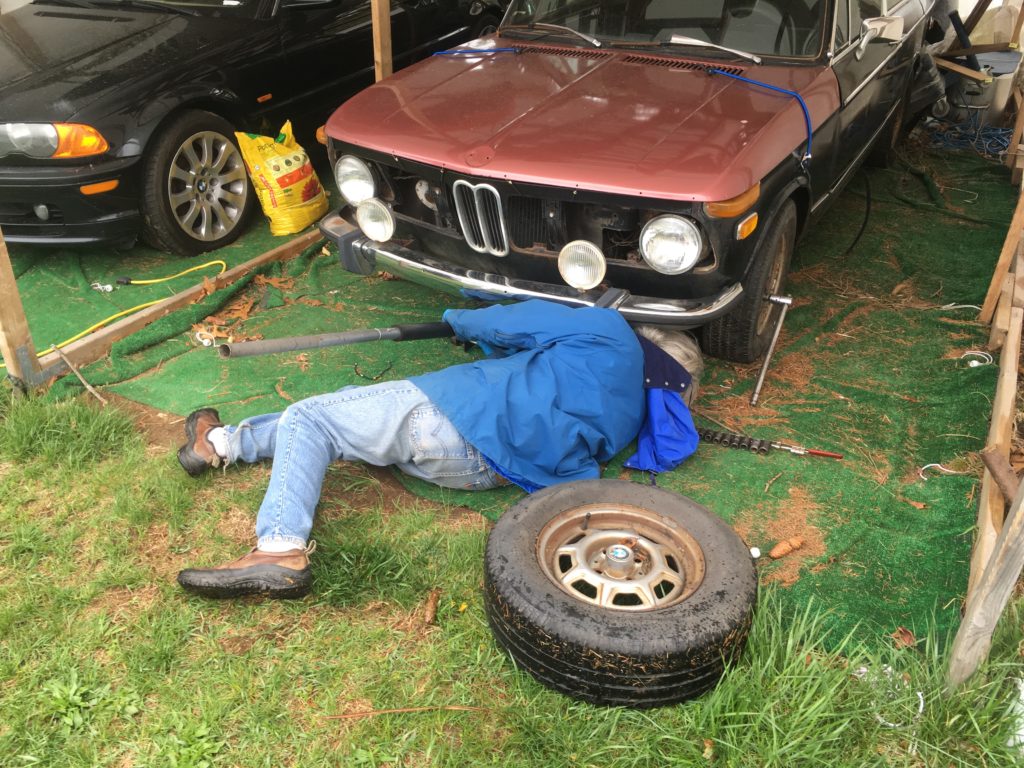
Positioning the floor jack under the front subframe. You don’t get a free car without getting your hands (and butt) dirty.
Next was the task of getting the car down onto the street. Tom asked me to assess the condition of the brakes. I got in the car and the first thing I found was that the brake pedal went straight to the floor and stayed there.
Actually, that’s not true. The first thing I found was that most of the interior was missing. The car had a driver’s seat, but not much else. With the passenger seat and the rugs gone, I looked to my right and was greeted by a yawning hole in the floor that looked like the crack in the universe in that multi-season-long Doctor Who arc. I thought “This is probably why I passed on the car last year.”
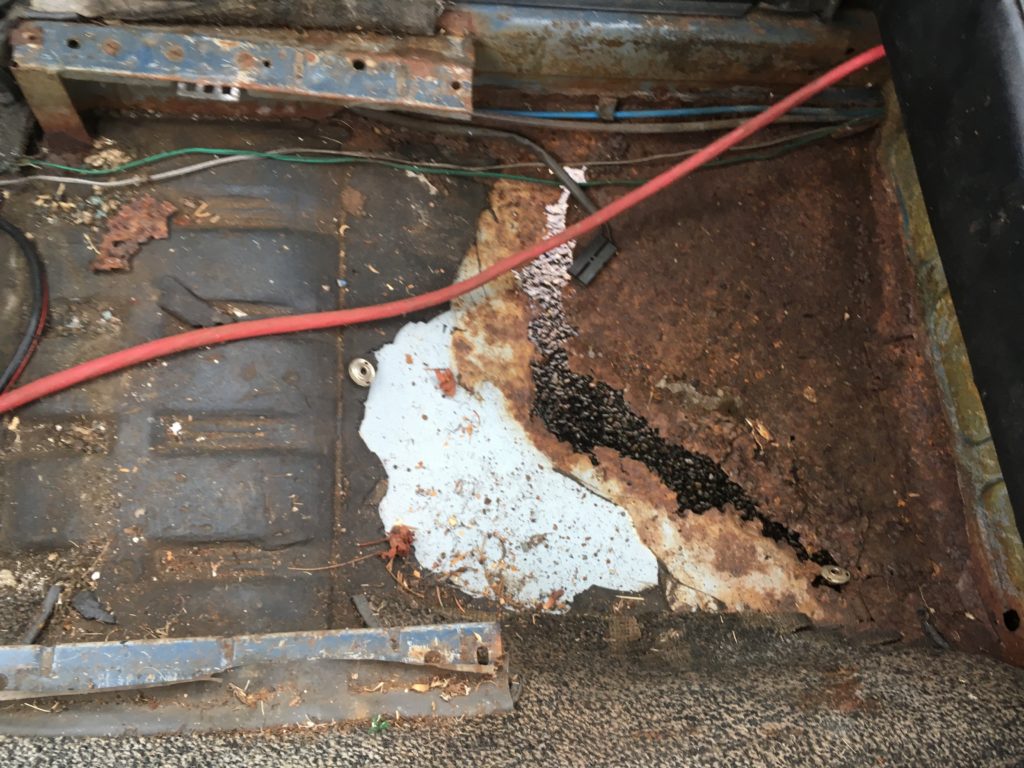
The floors were beyond bad.
I assumed that we were going to back Tom’s trailer up the hill so we could use its built-in winch, but Tom and the seller rocked the car back and forth and got the brakes to free up and the car to roll. The brake pedal, as I said, was non-functional, but I tested the handbrake and it appeared to do something, though how well it would slow the car while rolling down the steep front yard was unknown. Initially, Tom and the seller rolled it a few feet at a time while Tom serially moved a wheel chock forward in case the car began to gather too much momentum. But then Tom noted that the street had a slight incline, and offered that if we rolled the car down the hill and I turned onto the street in the direction leading up the incline, the car would naturally slow. The seller stood in the street and checked for traffic, Tom shoved, I steered, and in a few exciting seconds, the car was safely on the asphalt and an easy downhill roll away from the trailer.
With the car accessible on all four sides, I gave it a quick walk-around. The floors notwithstanding, it didn’t look that bad. There was a little rust at the bottoms of one of the fenders, but the rockers weren’t ventilated. The nose and rear quarters appeared to be in very good condition. The replacement hood was bungie-corded in place simply because it hadn’t been attached to the hinges yet. One rear shock tower clearly had been patched but showed no current rust. I know that it was a dead fake tii with a gutted interior and Fred Flintstone floors, but still… had I gotten it wrong a year ago?
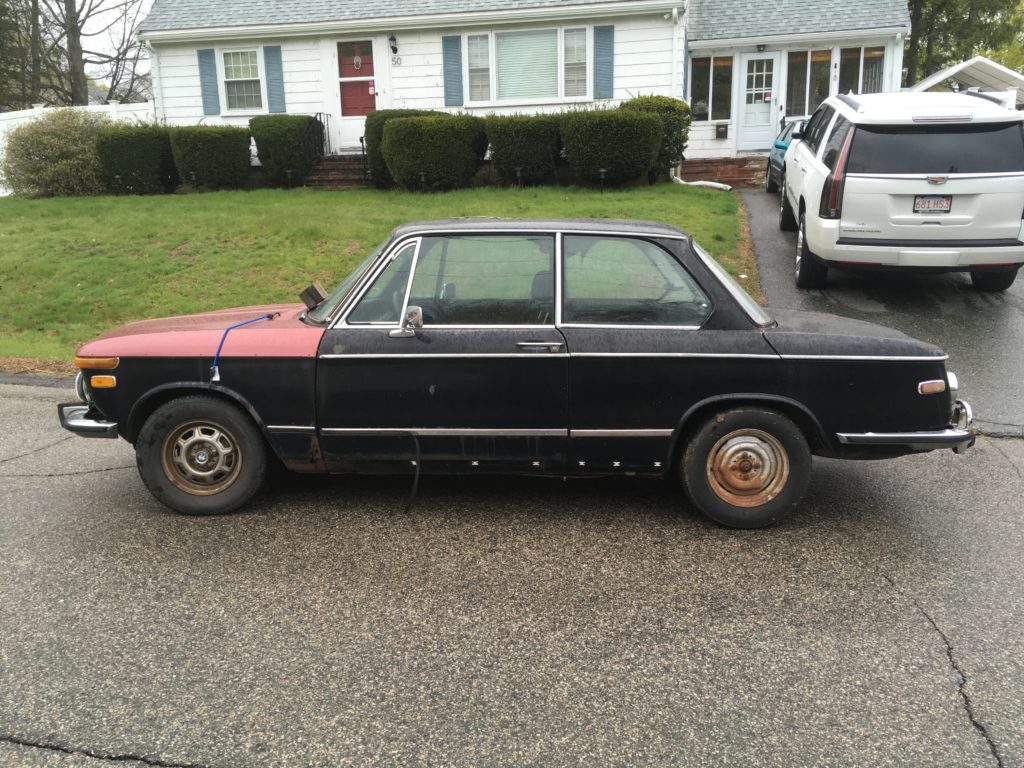
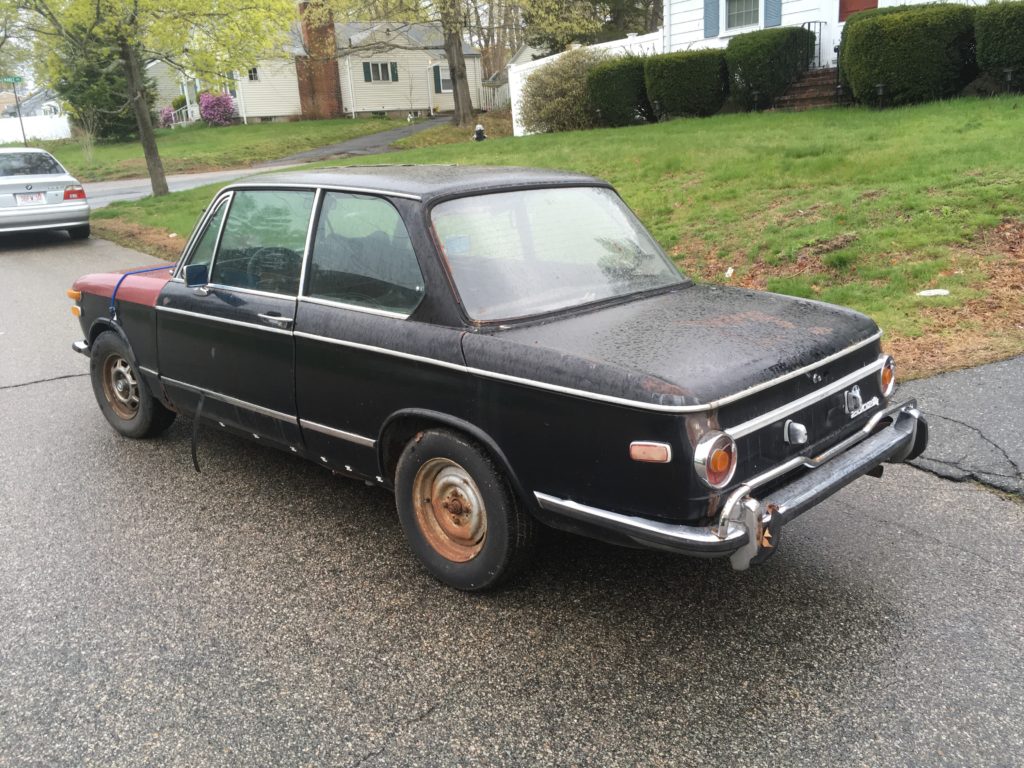
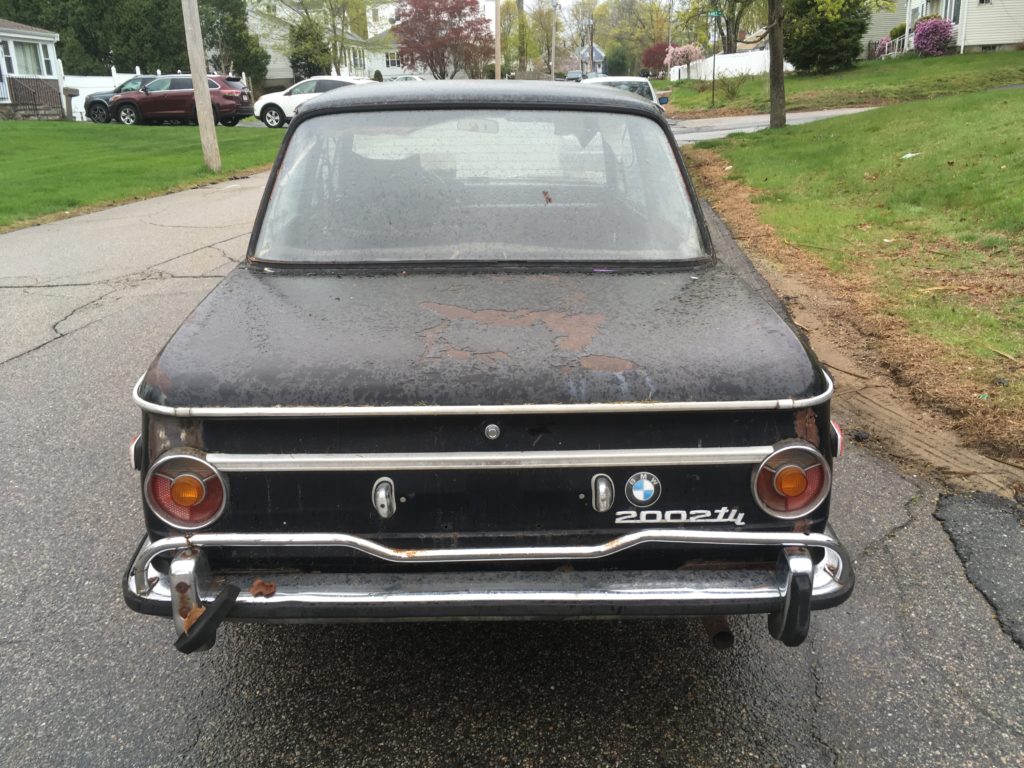 Tom had hours of driving left to do, and the rain was beginning to pick up, so I curtailed my sizing-up and we began the process of winching the faux tii into the trailer. As we circled the car, we both caught the unmistakable varnish-like smell of stale old gas. Once the car was in the enclosed trailer, the smell became quite strong, but we didn’t see fuel dripping from anywhere.
Tom had hours of driving left to do, and the rain was beginning to pick up, so I curtailed my sizing-up and we began the process of winching the faux tii into the trailer. As we circled the car, we both caught the unmistakable varnish-like smell of stale old gas. Once the car was in the enclosed trailer, the smell became quite strong, but we didn’t see fuel dripping from anywhere.
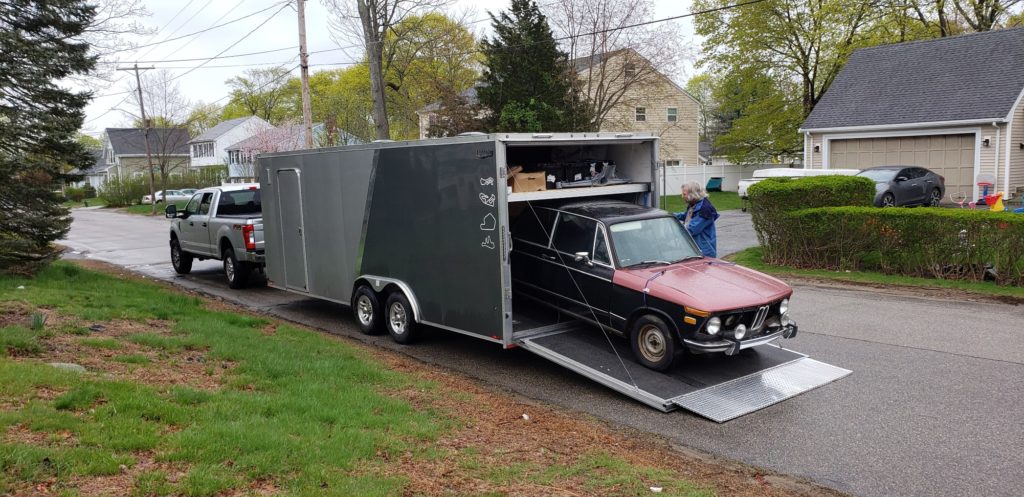
It’s great having a friend with not only a truck and a trailer, but a trailer with a winch. It makes dealing with dead cars so much easier.
As we were loading the car, the seller said “I have some other parts if you want them.” He walked me back to the structure where the car had been sitting and pointed toward the rafters. There were a pair of rust-free fenders, a door, and a trunk lid, all obviously from the same red 2002 that the hood had come from. I marveled at my good luck as he helped me carry them into the trailer. To draw the last cards of this inside straight, he even had the keys and a title for the car, and said that he’d gotten the engine running last summer using starter fluid. As they say, damn, Sam.
When we were done loading, I thanked the seller for his generosity and tried to hand him three $20 bills. He refused them. I said “Come on, you’re giving me things that are of value; let me at least give you dinner money.” He wouldn’t take it. “Forty bucks, then.” Still no. “Okay. Twenty. Beer money. But that’s my final offer.” He reluctantly accepted the lone Jackson.
Tom and I then headed home through the rain to Newton. I’d already moved the Winnebago Rialta RV so the faux tii could be unloaded and rolled down to the end of my driveway where it could sit with the other 2002 parts that came with Bertha when I bought her back last year. Tom and I snapped the car-bro-cheesecake shot below, and I then tried to do with him what I tried to do with the seller. I had even less success. “Come on, Tom,” I protested; “You incurred real cost helping me out. Let me at least pay for the gas.” He stood firm, and he’s much bigger than me, so he won.
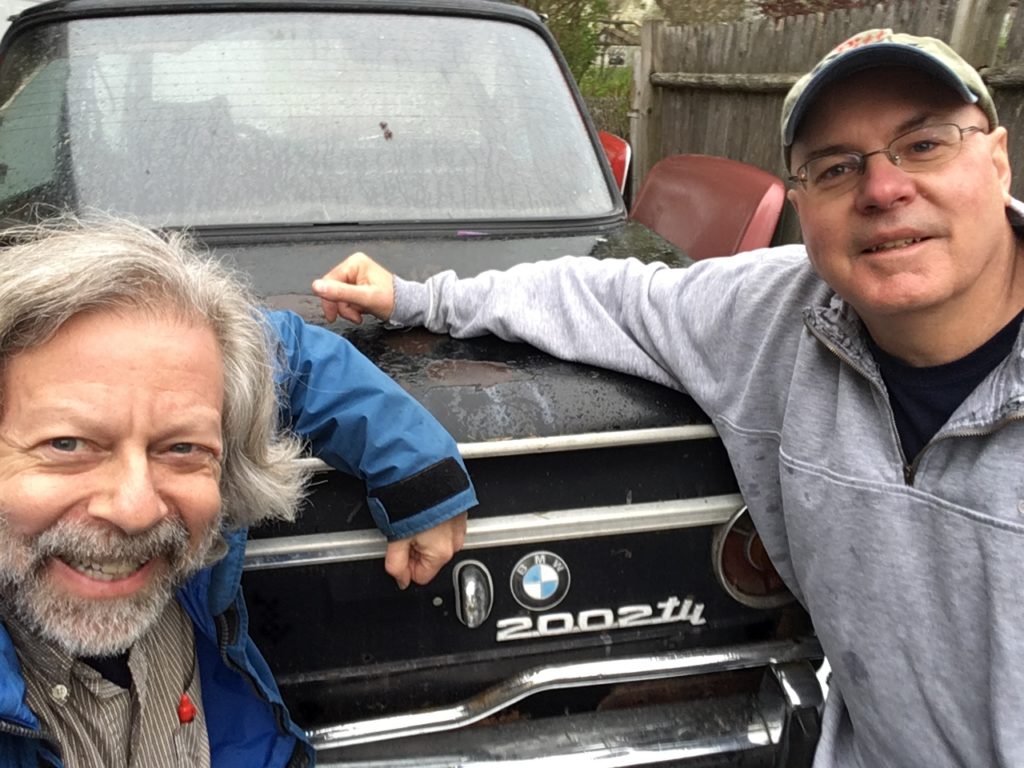
The pirates and their booty.
The next day, after the rain stopped, I had the chance to look at the car in more detail. First I checked the VIN stamped into the engine compartment and on the trim piece in front of the steering wheel. I’d done this last year, but I wanted to be certain. It read 2589847. Yup, a standard ’73 2002. Not a tii.
Next, I checked for tii-specific parts. Injected engine, check. Stuts with 3.5″ bolt spacing and big calipers, check. Big tii brake booster, check. Tii gas tank with return line, check. Clock in the dash (most faux-tiis don’t have this one), check. It even had the rare-as-hen’s-teeth five-by-thirteen inch non-slotted steel wheels that were only on the ’72 and ’73 tiis. Boxed rear trailing arms, however, were negative. It’s a rare faux-tii that has these. Also missing was the tii-specific air box, as faux tiis rarely have the welded-on mounting brackets that hold the box in place.
Then, it was time for the most important part; examining the undercarriage. I crawled under the driver’s side door to look at the left frame rail. It was there that I noticed what I’d forgotten from a year prior: The left frame rail was rotted and partially crushed. It’s not that this can’t be fixed, but unless the rest of a car is in very good condition—and this one certainly isn’t—it usually seals the verdict as “parts car.”

Unless the rest of a vehicle is excellent, on a long-sitting dead car, frame rail rot like this is usually is a death sentence.
As I moved to the back of the car, I found that, despite the yawning holes in the floors, they’d been welded once before, in a most ham-fisted manner (and this from me, whose fists have held great mounds of ham) with large angular pieces of untreated and now rusting metal slapped over rather than patched into the existing floor:
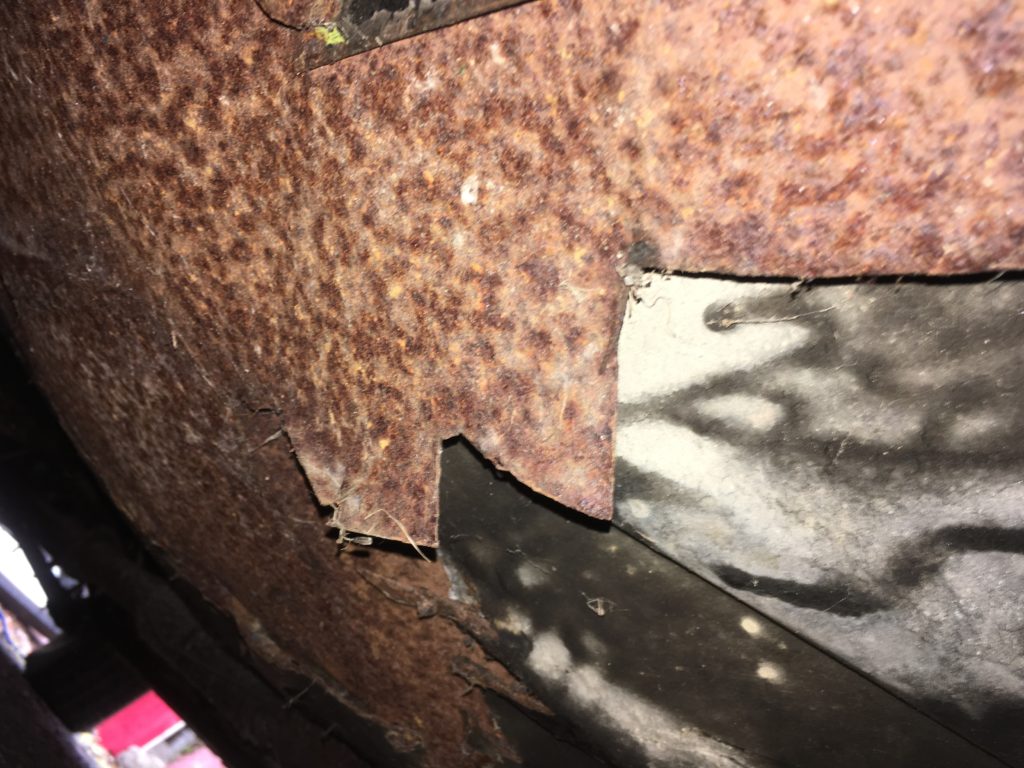
This attempt at fixing the floor looks like it was done in anger.
I also saw that the tii-specific rear-mounted electric fuel pump had been plumbed in an interesting fashion, with what looked like metal brake line:

An unsecured metal line was running to the fuel pump.
I was also curious how the fuel pump itself was attached, as the mounting bracket welded to the underside of the car is tii-specific. The answer is: It wasn’t. Attached, that is. That likely explained the gas smell.
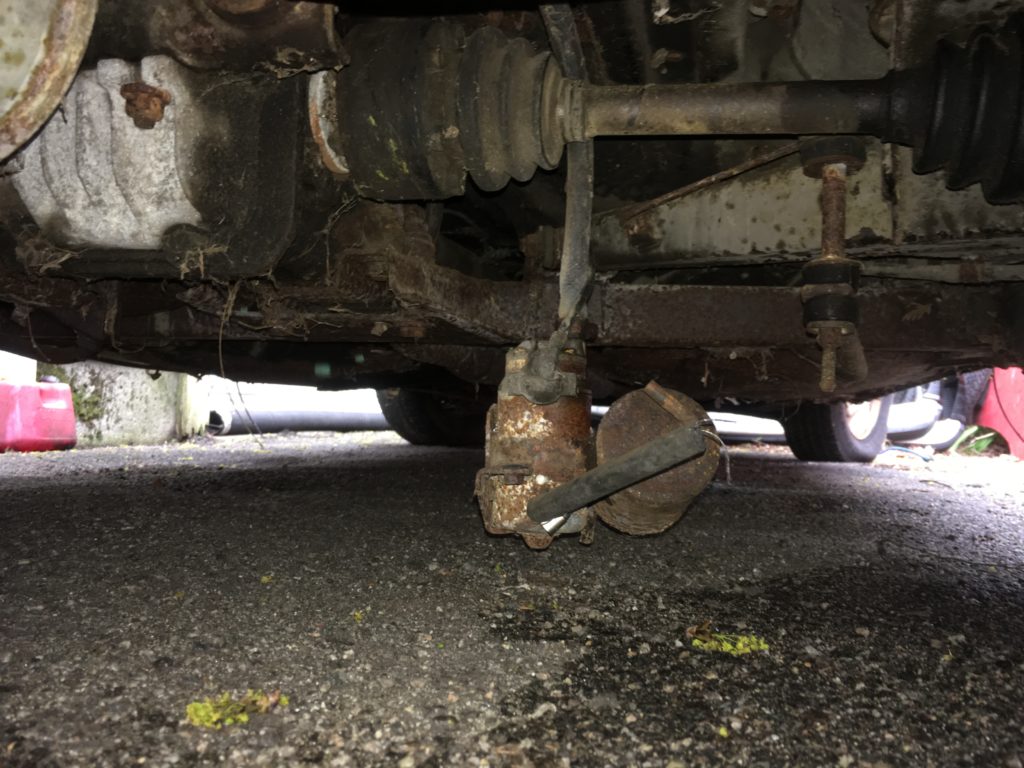
The fuel pump was just swingin’ in the breeze.
Lastly, although everyone concentrates on the shock towers the way people comment whether gymnasts “stick the landing,” the other big structural point is where the rear subframe bushings bolt to the underside of the car. It’s easiest to check these by pulling up the back seat. I found that the metal near both attachment points was rusty, with the left side already having been repaired once, and badly. It was hard to tell if I was looking at welding spatter or rodent dung.
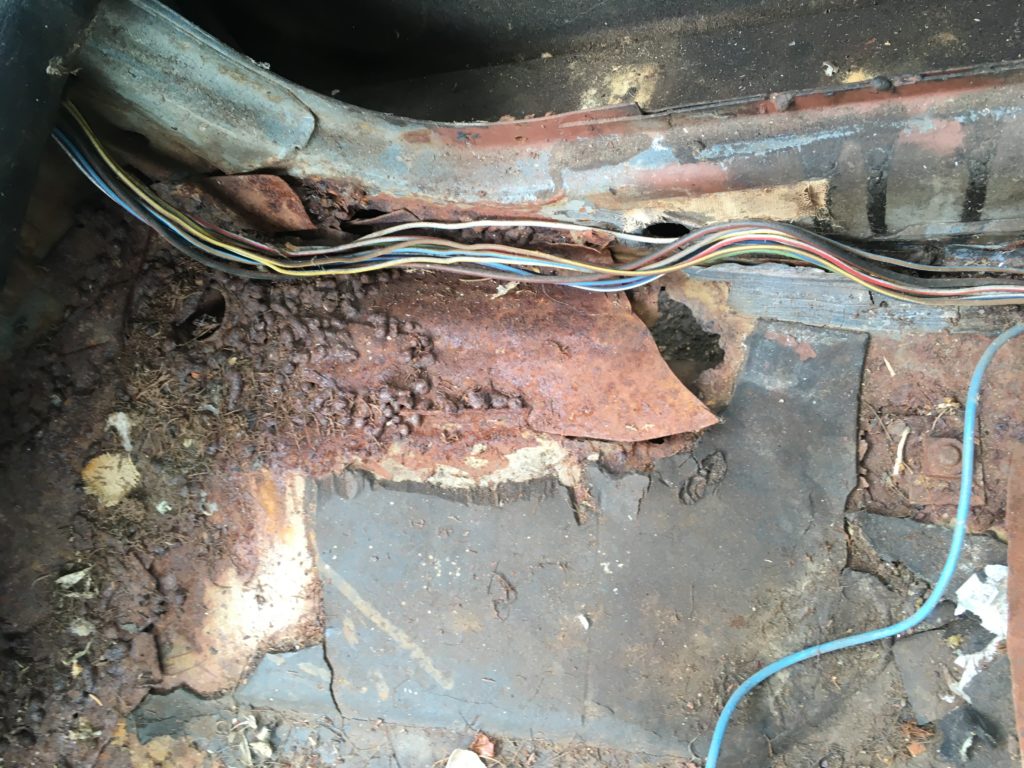
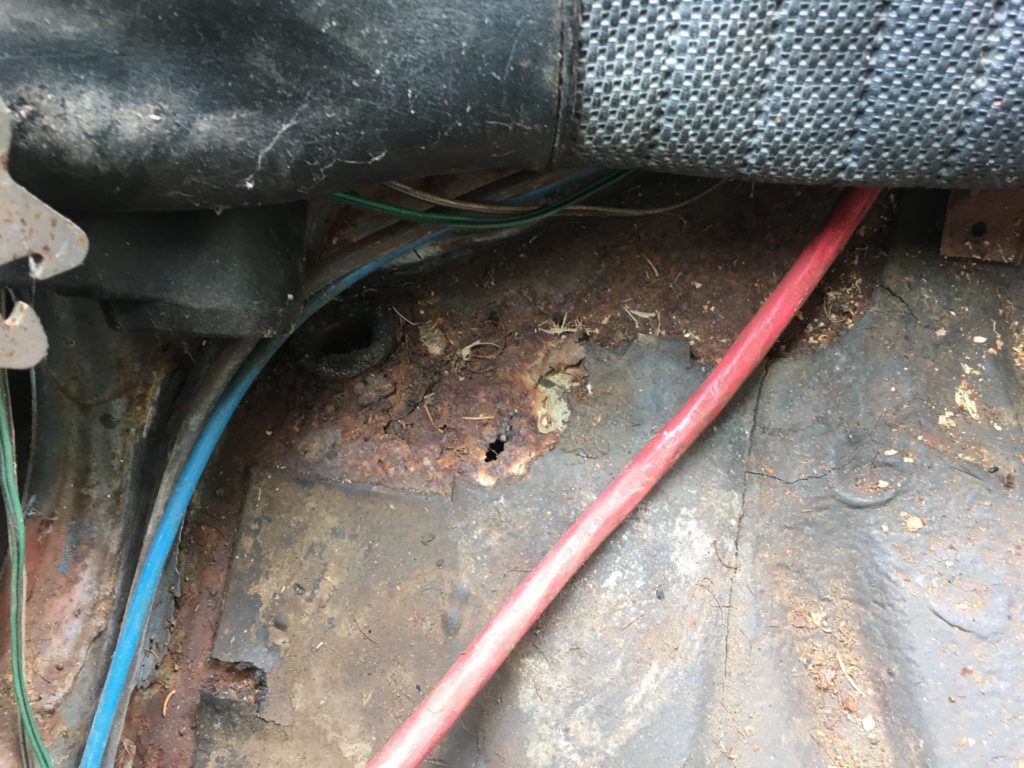
When I looked at the inside corner of the left rear wheel well, closest to the already-repaired subframe mount, I could see where it had been patched once before, also quite badly.
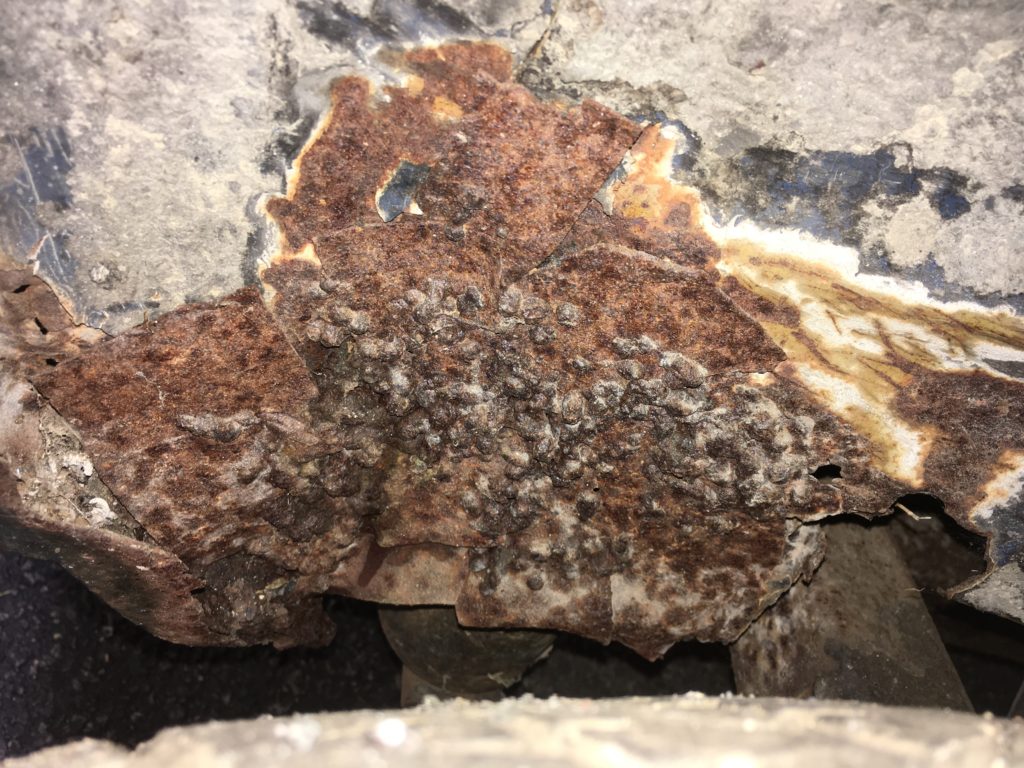
Yeesh!
There was one piece of good news I discovered while under the back of the car. I smiled when I saw the characteristic yellow and blue of Bilstein shocks. I haven’t read a part number off them, but when I bounced the rear, they felt like HDs (heavy duty). I’d need to do more work to tell what the front struts are, but bouncing them, they also felt like HDs.
The decent outward appearance and the goodies notwithstanding, it’s pretty clear to me that this is a parts car. Other potential buyers probably felt the same. It’s not like I was the only one who knew about it. He had it on Craigslist. No one snatched it up.
Now, if this is sounding like déjà vu, it’s because, a few years back, for $250, I bought “The Turkey,” a similar can’t-turn-it-down-at-that-price car whose rear subframe attachment point was so rotted that the right corner of the subframe was literally left dangling. However, the rest of that car was largely intact, it had been stored indoors, and it had a very appealing interior, so when a “Save The Turkey” campaign started on Facebook, with none other than Mike Miller publicly shaming me into granting it a stay of execution, I relented, put some time into it, got it running and driving, and sold it to someone else who intended to save it. I kid Mike, but it was, actually, the right thing to do. But this car is worse in several ways, most notably the rotted frame rail.
So my short-term plan is this: Do nothing. I need to turn my attention to Bertha and leave it there or I won’t get her prepped in time to drive her down to the Vintage (I’ll need to depart a week from next Wednesday). When I get back, I’ll re-examine the faux tii, investigate the seller’s tantalizing statement that it started as recently as last year, and take it from there.
If you’ve been reading my work long enough, you know that I’m most attracted to the story a car has to tell. “I got it for free, stripped it for parts, and had the shell hauled off for scrap” may well be what happens, but it isn’t really a great story. We shall see what’s in store for the faux tii. Or, probably more accurately, we shall see what it has in store for me.—Rob Siegel
Rob’s new book, Just Needs a Recharge: The Hack MechanicTM Guide to Vintage Air Conditioning, is available here on Amazon. His previous book Ran When Parked is available here. Or you can order personally inscribed copies of all of his books through Rob’s website: www.robsiegel.com.

